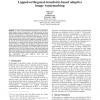Free Online Productivity Tools
i2Speak
i2Symbol
i2OCR
iTex2Img
iWeb2Print
iWeb2Shot
i2Type
iPdf2Split
iPdf2Merge
i2Bopomofo
i2Arabic
i2Style
i2Image
i2PDF
iLatex2Rtf
Sci2ools
JEI
2006
2006
Lapped-orthogonal-transform-based adaptive image watermarking
A robust, invisible watermarking scheme is proposed for digital images, where the watermark is embedded using the blockbased lapped orthogonal transform (LOT). The embedding process follows a spread spectrum watermarking approach. In contrast to the use of transforms such as discrete cosine transform, our LOT watermarking scheme allows larger watermark embedding energy while maintaining the same level of subjective invisibility. In particular, the use of LOT reduces block artifacts caused by the insertion of the watermark in a block-by-block manner, hence obtaining a better balance between invisibility and robustness. Moreover, we use a human visual system (HVS) model to adaptively adjust the energy of the watermark during embedding. In our HVS model, each block is categorized into one of four classes (texture, fine-texture, edge, and plain-area) by using a feature known as the texture masking energy. Blocks with edges are also classified according to the edge direction. The block clas...
| Added | 13 Dec 2010 |
| Updated | 13 Dec 2010 |
| Type | Journal |
| Year | 2006 |
| Where | JEI |
| Authors | Yuxin Liu, Bin Ni, Xiaojun Feng, Edward J. Delp |
Comments (0)

